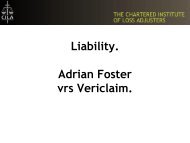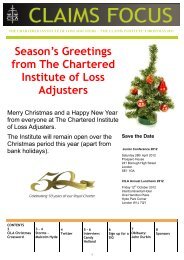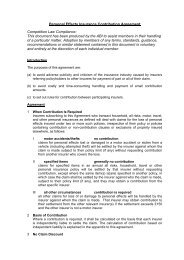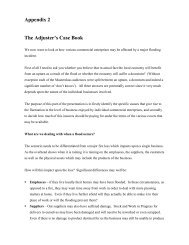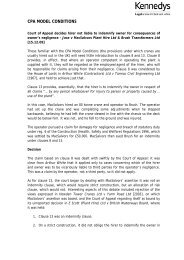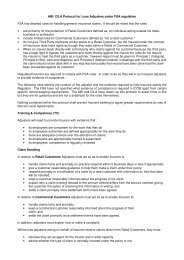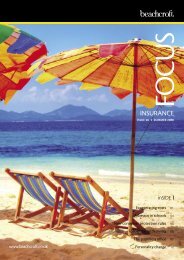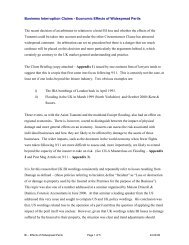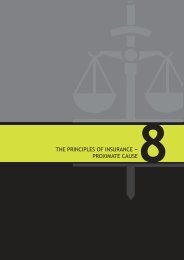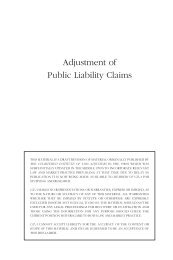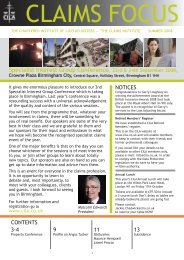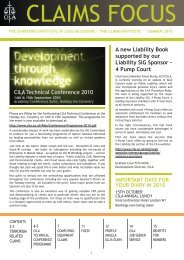privileg.. - CILA/The Chartered Institute of Loss Adjusters
privileg.. - CILA/The Chartered Institute of Loss Adjusters
privileg.. - CILA/The Chartered Institute of Loss Adjusters
Create successful ePaper yourself
Turn your PDF publications into a flip-book with our unique Google optimized e-Paper software.
LEGAL PROFESSIONAL PRIVILEGE AND WITHOUT PREJUDICE COMMUNICATIONS:A PRACTICAL OVERVIEW FOR LOSS ADJUSTERSELSPETH OWENS, 4 PUMP COURTIntroduction1. <strong>The</strong> application <strong>of</strong> Legal Pr<strong>of</strong>essional Privilege to documents produced by third parties who areneither ‘the client’ nor ‘the solicitor’ can be a source <strong>of</strong> misunderstanding and uncertainty.Documents produced or procured by loss adjusters fall within this category. If an insurer instructsa loss adjuster to produce a report in relation to a claim made by an insured, does that report haveto be disclosed in any subsequent litigation? What if a loss adjuster takes statements from theinsured, or procures a report from an expert, do those documents have to be disclosed? This paperseeks to provide an overview <strong>of</strong> the rules governing disclosure and to examine the application <strong>of</strong>Legal Pr<strong>of</strong>essional Privilege in the particular context <strong>of</strong> documents procured or produced by lossadjusters. <strong>The</strong> paper also seeks to provide a brief overview <strong>of</strong> the rules on Without Prejudicecommunications as a related topic which can also be source <strong>of</strong> uncertainty.Disclosure2. In cases allocated to the fast-track or the multi-track 1 , the court will usually make an order for‘standard disclosure’. Standard disclosure requires a party to disclose 2 :2.1 <strong>The</strong> documents on which he relies; and2.2 Documents which:2.2.1 Adversely affect his own case;2.2.2 Adversely affect another party’s case; or2.2.3 Support another party’s case; and1 CPR Part 31 does not apply to small claims proceedings – CPR r.27(1)(b). Instead the court will usually give adirection that each party shall, at least 14 days before the date fixed for the final hearing, file and serve on everyother party copies <strong>of</strong> all documents (including any expert’s report) on which he intends to rely at the hearing (r.27(3)(a)(i)).2 CPR r.31.61
on that list the ground on which the right to withhold is being asserted 5 . It follows that all relevantdocuments produced / obtained by a loss adjuster in connection with a dispute (including anyreports, letters, emails, statements etc) must be disclosed and can be inspected by the other partyunless they fall within one <strong>of</strong> the exceptions to the general rule allowing inspection. <strong>The</strong> key right(arising at common law) to withhold inspection <strong>of</strong> a document where the document has beenprocured or produced by a loss adjuster is Legal Pr<strong>of</strong>essional Privilege.Legal Pr<strong>of</strong>essional Privilege7. <strong>The</strong>re are two classes <strong>of</strong> Legal Pr<strong>of</strong>essional Privilege:7.1 Legal Advice Privilege; and7.2 Litigation Privilege.Legal Advice Privilege8. In order to attract Legal Advice Privilege the relevant document must satisfy the followingcriteria:8.1 It must be a communication between the lawyer and the client;8.2 <strong>The</strong> communication must be a confidential communication;8.3 <strong>The</strong> lawyer must be acting in his pr<strong>of</strong>essional capacity; and8.4 <strong>The</strong> purpose <strong>of</strong> the communication must be the seeking or giving <strong>of</strong> legal advice orassistance.For Legal Advice Privilege it is irrelevant whether litigation is pending or contemplated or not.9. In order to assess whether the criteria are met in relation to a particular document, it is essential tounderstand what is meant by “lawyer” and “client” in this context:9.1 “Client”: In Three Rivers 6 the Court <strong>of</strong> Appeal held that the “client” is the person whoretains the solicitor. Where the party is a company or corporation, the Court interpreted5 CPR r.31.19(3)6 Three Rivers District Council v Governor and Company <strong>of</strong> the Bank <strong>of</strong> England (No. 5) [2003] QB 15563
20. Legal Pr<strong>of</strong>essional Privilege belongs to and may be waived by the person who has the right to the<strong>privileg</strong>e in it. This is the client rather than the lawyer. Privilege may be waived either expresslyor implicitly by allowing the other side to inspect the document. A witness statement prepared forpending or anticipated litigation, for example, is a <strong>privileg</strong>ed document, but <strong>privileg</strong>e is waivedwhen the statement is served on the other side 10 .21. If a party waives <strong>privileg</strong>e to part <strong>of</strong> a document, <strong>privileg</strong>e is usually waived for the wholedocument, unless the other parts deal with an entirely different subject matter 11 .22. Privilege may also be lost by inadvertent disclosure. However, CPR r.31.20 provides that, wherea party inadvertently allows a <strong>privileg</strong>ed document to be inspected, the party who has inspectedthe document may only use it or its content with the permission <strong>of</strong> the court 12 .Without Prejudice Communications23. A further category <strong>of</strong> documents <strong>of</strong>ten referred to as giving rise to a form <strong>of</strong> <strong>privileg</strong>e is withoutprejudice communications. Without prejudice communications are inter-party correspondence(whether oral or in writing) genuinely aimed at settlement <strong>of</strong> the dispute. It is therefore not rightto describe them as giving rise to a right to withhold inspection. <strong>The</strong> very nature <strong>of</strong> a withoutprejudice communication is that it is an inter-party correspondence. It follows that both partieswill have a copy <strong>of</strong> it. Without prejudice communications are not therefore communications thatcan be withheld from inspection by the other side – rather they are communications that can bewithheld from the court. <strong>The</strong> reason for this is that it could obviously damage a party’s case (andconsequently inhibit the settlement process) if the court were entitled to see <strong>of</strong>fers andconcessions that may have been made by a party in an attempt to reach settlement.24. <strong>The</strong> communication does not need to contain the words ‘without prejudice’ to attract theprotection, it is the substance <strong>of</strong> the document rather than its label which is relevant. Conversely,a document headed ‘without prejudice’ does not necessary make it a without prejudicecommunication. <strong>The</strong> test is whether its purpose is a genuine attempt at settlement.10 Re Rex Williams Leisure plc [1994] Ch 350, CA11 Great Atlantic Insurance Co. v Home Insurance Co [1981] 1 WLR 52912 <strong>The</strong> relevant principles applied by the court in deciding whether to grant permission are set out in Al-Fayed vCommissioner <strong>of</strong> Police <strong>of</strong> the Metropolis [2002] EWCA Civ 780 at [16].9
25. Once a document is protected in this way, it cannot be shown to the court, even on the question <strong>of</strong>costs, unless the protection is waived by the parties jointly 13 . Where, however, without prejudicenegotiations have resulted in a settlement, the communications are admissible to prove the terms<strong>of</strong> the settlement 14 .26. Given the restriction on using without prejudice communications in court in relation even tocosts, it is common for without prejudice communications to be marked “Without Prejudice SaveAs To Costs”. This allows the document to be produced in court when costs come to bedetermined.ELSPETH OWENS4 PUMP COURT13 Rush and Tompkins Ltd v Greater London Council [1989] AC 1280, HL14 Walker v Wilsher (1889) 23 QBD 33510



